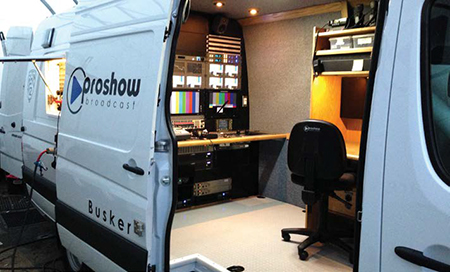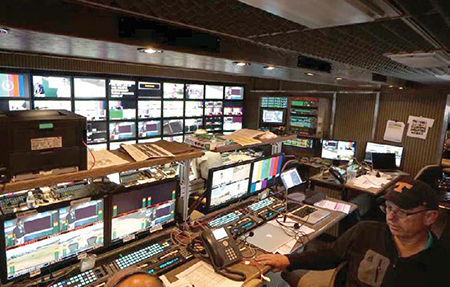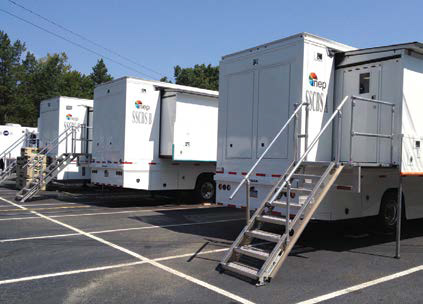Smaller Trucks Driving Into Larger Markets
BALTIMORE—With the increasing acceptance of IP-based routing that allows broadcasters to present any type of sporting event—from the large-scale to the obscure—televising events with a skeletal staff can result in significant cost savings over time. It makes economic sense that, with just an engineer and a shooter based out of small truck on location—and the announcers, graphics, slo-mo, etc., working from the broadcast center, with additional content stored in the cloud—a simpler approach can work.
That doesn’t mean next year’s Major League Soccer All-Star Game, for instance, is going to be broadcast without big HD trucks from the usual suspects. But given cost savings on personnel and the crew’s travel expenses and the increased demand for programming, cost-conscious broadcast executives are contemplating that option.

Pac-12 Networks, the TV and multimedia company of the Pac-12 Conference, uses Sprinter vans outfitted for mobile production to cover conference games.FROM THE BOOTH?
Jim DeFilippis, formerly of the Fox Technology Group and now president of Technology Made Simple in Pacific Palisades, Calif., said that this concept is not especially new.
“I recall people predicting this trend in the late ’90s, with the advent of fiber,” he said. “The challenge has always been the need for some physical presence to shoot and shade cameras, to place mics or to be there in case something goes wrong. And that most talent wants to be part of the event, not working from the broadcast center.”
John Salzwedel, president and owner of Madison, Wisc.-based Token Creek Mobile Television, offered this example: “ESPN is sending multicamera transmissions from the venues to headquarters in Bristol [Conn.] from a small truck and handling everything else, including the announcers and graphics” remotely, he said.
However, these units aren’t what are normally considered a production truck. “They’re basically Sprinter vans that can only accommodate [two people who] make sure that everything is wired correctly, with dark fiber [which more sports arenas now have available to broadcasters], to an uplink truck,” Salzwedel said.
They’re typically used for “Olympic” profile sports, like an NCAA volleyball match that doesn’t garner a large enough audience to make money. “They wouldn’t be [taking that approach] for the Wisconsin- Michigan football game, but they’ll use it for Wisconsin-Michigan volleyball match,” said Salzwedel of this more antiseptic approach, which was pioneered by the Pac-12 Networks and is also employed by the Big 10 Network, among others.
Get the TV Tech Newsletter
The professional video industry's #1 source for news, trends and product and tech information. Sign up below.
However, he stated, observers who wonder if this trend might point toward the end of large mobile units are mistaken. “There is still much to be said for having your entire crew at the venue” to observe events as they happen.
Salzwedel says viewers are getting wise, too. “When they watch a soccer match on ESPN between Equador and. Portugal, they can often tell if the announcers are calling the game from Bristol,” he said, “if a player suddenly disappears and [the announcers] miss a player holding his injured arm and walking off the field, for instance. To see details, they have to be there.”

The production room in Game Creek Video’s Glory double expando, which was used to cover the U.S. Open men’s golf championship on Fox.WHERE IS IT LEADING?
Fred Gerling, president of mobile production company Gerling & Associates of Sunbury, Ohio, said that even the large mobile units are sometimes used during smaller events.
“Several of our large ‘A Game’-type trailers have performed well this year doing REMI shows (where the transmissions are streamed to another facility where graphics, etc., are added),” he said. “The concept is great, as long as there is dark fiber from the venue to the final production facility; I must say, though, it was weird seeing a large remote television broadcast trailer doing an event crewed only by an engineer and a cameraman, but there will be such combinations in the future.”
All told, he believes the technological approach will come to the fore “in airing ‘Olympic’ sports” for universities as networks, such as ESPN 3 and the like, as they gain momentum—especially with newer equipment, like the Ross Carbonite switcher and its matching graphics system, which emulate the “big broadcast” that every outlet wants.
“We’re seeing considerable activity in that area now with smaller truck systems and this will lead to considerable pay-per-view broadcasting,” Gerling said, “and to added programming outlets using the cloud. It’s the concept of putting a truck in the field with limited crew that people are thinking hard about.”
NEP, CBS Go Really Big
While producing the smaller (e.g., low revenue) events with small trucks is definitely a trend, a regular season major league sporting event requires the usual large mobile units and a complete crew, and they aren’t going away.

The four-trailer SSCBS production unit consists of three 53-foot double expandos and one 53-foot straight trailer. That point was recently driven home with last month’s announcement that NEP Group and CBS have joined forces to use the Evertz IP routing system on the new, four-trailer SSCBS production unit that recently debuted at the PGA’s Wyndham Championship in Greensboro, N.C.
The unit, which consists of three 53-foot double expandos and one 53-foot straight trailer, will take to the nation’s interstates for CBS 48 weeks out of the year as the main production unit for the network’s PGA golf coverage. It will also be used for NFL Network’s Thursday Night Football broadcasts (eight of which will also air on CBS) and for Super Bowl 50.
The decision to employ IP routing in the construction of SSCBS was done for a number of reasons, including 4K capability and the expectation that cameras, switchers and digital disc recorders used for replays will eventually be controlled via IP.
“I think between the IP routing and the IP intercom system, it will add an incredible amount of flexibility to CBS’s production capabilities,” Joe Signorino, vice president of systems integration for NEP. “This is one of the largest unit systems we’ve put together and we’re well braced for the future.”
Mark R. Smith
Also on board with that train of thought is Jason Taubman, vice president of new design and technology with Hudson, N.H.- based Game Creek Video. “We don’t think it will decrease the amount of larger trucks that are in need, but will add to the number of smaller trucks the market demands,” he said. “That also might mean that, sometimes we use a larger truck for a smaller event, which we have done recently with an ESPN REMI show.”
As for the cloud angle, George Hoover, chief technical officer with Pittsburgh-based NEP Group—(*TV Technology originally referred to Hoover as former CTO and now consultant. We regret the error)—feels it “represents a significant opportunity within the mobile industry. We’re running 10-100 Gigabit networks between servers now,” he said. “In order to connect into the cloud, we need that same kind of bandwidth to move content.” (See sidebar)
HIGH IN THE SKY
Hoover noted that a number of broadcasters already operate clouds, including NBC Sports and Turner Sports. “So we’re making that connection, as we do for every NFL game, for instance,” he said.
What the cloud provides now, he added, is “greater access to off-site content, particularly archival material, features and graphics, and editing capabilities that are beyond what’s typically available on a truck.” That trend is already prominent in major league sports broadcasts “and I think we’ll see it making its way into major college venues and eventually smaller college venues, too.”
DeFilippis thinks the small model “will still cost money to implement, thus will happen slowly, organically, over time, since the payback isn’t that big. The challenge now is that the IT world has jumped up to 25 or 35 gigabits, but that means nothing unless you have proper throughput.”
Ultimately, he said, competing will require a bump up to 4K, “but the sports people might not want to do that.” The other issue is the dearth of skilled workers in the pipeline.
“The job isn’t as high-paying or glamorous as it was and many younger people are considering other industries,” DeFilippis said. “So, there’s an age gap. If a veteran is working from the studio, there’s not a young person honing his trade in the field. This is more work with less people.”
Mark R. Smith has covered the media industry for a variety of industry publications, with his articles for TV Technology often focusing on sports. He’s written numerous stories about all of the major U.S. sports leagues.
Based in the Baltimore-Washington area, the byline of Smith, who has also served as the long-time editor-in-chief for The Business Monthly, Columbia, Md., initially appeared in TV Technology and in another Futurenet publication, Mix, in the late ’90s. His work has also appeared in numerous other publications.

